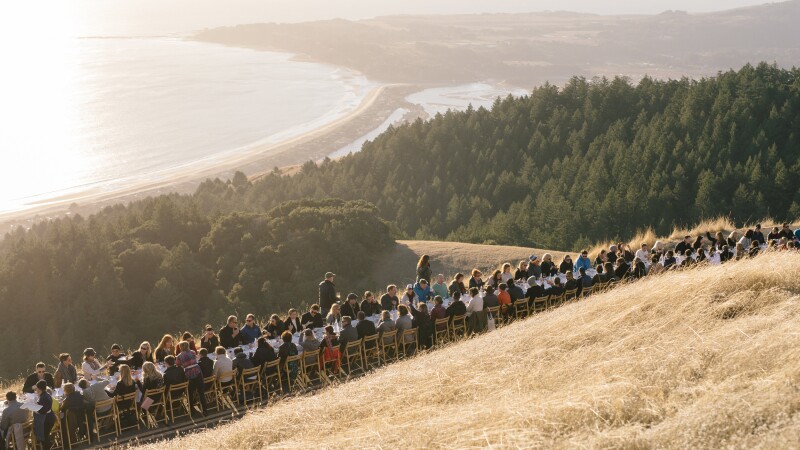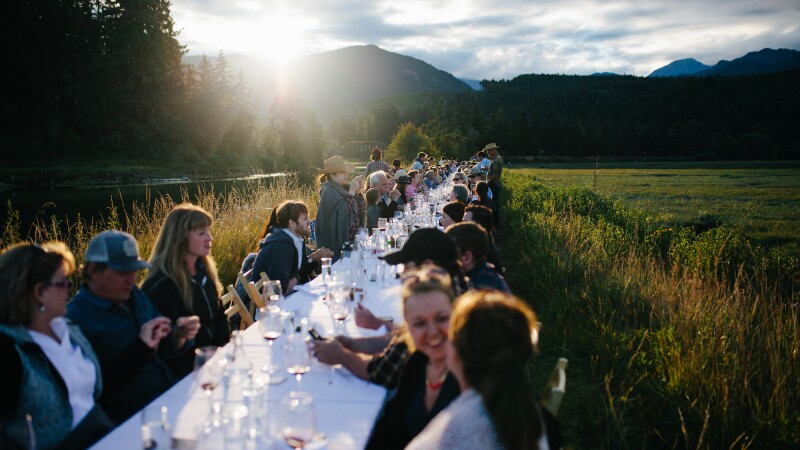On a sprawling farm in of one of Mexico’s loveliest colonial cities, San Miguel de Allende, a yards-long table is set under a canopy of trees. Nearby, a chef darts toward a brick-walled fire pit to sample the slow-smoked goat that a farm worker volunteered to baste with the juice of bitter oranges. When guests finish their tour of the property’s greenhouses, horse barns, and sustainable ponds, they’ll carry their own plates to the table, which is set with a white cloth, fresh bread, tiny radishes grown in the nearby fields, and glasses of local wine. This bucolic scene is something out of a fairy tale, and it’s the brainchild of Jim Denevan.

An Outstanding in the Field dinner at Bodega Organica, an urban farm in San Miguel de Allende, Mexico
Photo by Allegra Ben-Amotz
Since 1999, Denevan’s organization, Outstanding in the Field, has hosted open-to-the-public ticketed dinners in all 50 states and at least 15 different countries. Not content with farm-to-table, Denevan actually brings the table to the farm, inviting chefs and farmers to work together to produce a meal that tells a story about its creators and about the place where the food is grown. In nearly 20 years of throwing dinner parties around the world, Denevan has learned a thing or two about different dining cultures—and about the magic that can happen when those culturally specific ideas are challenged.
As much time as he spends on table placements that correspond with the angle of the setting sun or what to do in the event of rain, Denevan is mainly concerned with getting people to pay attention to what they’re eating and where it comes from. To do so, he thinks of these dinners as interventions, a concept drawn from the art world. This often means manipulating the setup to interact with the natural surroundings. He may time the entrée to coincide with high tide on a private beach near Santa Cruz so that the swell tickles guests’ toes. Or he may set the table on a fallow field at Blue Hill at Stone Barns in New York so that farmers can help diners visualize the future of the farm’s bounty. The goal is to disrupt guests’ perceptions of what a meal—especially one they pay for—should look like.

A dinner on Mount Tamalpias in Marin County overlooked the Pacific Ocean.
Photo by Simone Anne
To engage people in the event, Outstanding in the Field’s guests are invited to bring their own plates to eat from; it’s both a conversation starter and a way to make them feel that they’re not just being fed but feeding the experience. At the end of the night, the staff cleans and returns everyone’s plates. Diners in most countries are delighted with the tradition, but at a dinner in The Netherlands, Denevan recalls, the Dutch took the concept a step further. Everyone happily agreed to go home with different plates than the ones they’d brought, as a token of the night.
“People need to get out to feel a few raindrops, to hear from the farmer in their own voice . . . it’s good for you.”
At dinners in countries with strong existing food cultures, expectations tend to be more pronounced, and the results, in many cases, are more powerful. In Spain, diners are accustomed to sitting down for dinner around 10 p.m., but Outstanding in the Field dinners are always timed to reach a pinnacle—the dessert course—as the sun is setting or has just set. “They called it a late lunch,” Denevan laughs. In Brazil, the concept of dining together with strangers is common, but in Wales, it’s unfamiliar. “There are countries where family-style dining is not done, where no one has ever seen a platter that you pass to your neighbor, at a dinner you paid for,” he says. “They are simultaneously like, ‘Are you confronting our culture? Is this right?’ Yet they go with it.”
But it’s the way people come together to embrace the unexpected that makes meals like these unforgettable. One of the most memorable events for Denevan was a collaboration between an American chef and a Japanese soba master set at Fujisan Winery, in the foothills of Mount Fuji. The day before, he’d cut through six-foot-tall grasses to position the table at an elevated point, curving it to match the slope of the world’s most symmetrical volcano. It was a cloudy time of year, and locals had told him there could be a period of weeks when the view of the mountain was obstructed. As soon as the guests arrived, they asked Denevan to point them in the right direction, hoping to catch a glimpse of the volcano. But there was no visibility. Then, 10 minutes after everyone sat down, for a brief moment—not more than a few seconds—the clouds parted and the whole of Mount Fuji emerged. The table burst into spontaneous applause. “When everything goes the way you think it will, it’s more easily forgotten,” he says. “But being ready to be surprised—that’s when magic happens.”

An Outstanding in the Field dinner at Hama Hama Oysters, on the west shore of the Hood Canal in Puget Sound
Photo by Neringa Greiciute
Ten or 20 years ago, the idea of paying and traveling to eat outside with strangers was a totally foreign concept. The phrase “farm-to-table” hadn’t even entered the lexicon. Now, travelers are willing to cross countries and pay top dollar for outdoor farm dinners; regional organizations such as Oregon’s Secret Suppers and Field and Vine, Connecticut’s collective Dinners at the Farm series, and Arizona’s Cloth and Flame are all following Outstanding in the Field’s lead. It’s caught on, Denevan believes, out of necessity: With the advent of smartphones, our ability to connect with others and to our surroundings is in danger. “People need to get out to feel a few raindrops, to hear from the farmer in their own voice,” he says. “It’s the expression of culture within nature, and it’s good for you.”
>>Next: Secluded Mountain Restaurants That Are Worth the Trek











